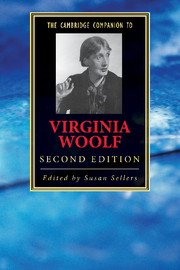Book contents
- Frontmatter
- 1 Bloomsbury
- 2 Virginia Woolf’s early novels: Finding a voice
- 3 From Mrs Dalloway to The Waves: New elegy and lyric experimentalism
- 4 The novels of the 1930s and the impact of history
- 5 Virginia Woolf’s essays
- 6 Virginia Woolf, modernism and modernity
- 7 The socio-political vision of the novels
- 8 Woolf’s feminism and feminism’s Woolf
- 9 Virginia Woolf and sexuality
- 10 Virginia Woolf, Empire and race
- 11 Virginia Woolf and visual culture
- 12 Virginia Woolf and the public sphere
- Guide to further reading
- Index
10 - Virginia Woolf, Empire and race
Published online by Cambridge University Press: 28 July 2010
- Frontmatter
- 1 Bloomsbury
- 2 Virginia Woolf’s early novels: Finding a voice
- 3 From Mrs Dalloway to The Waves: New elegy and lyric experimentalism
- 4 The novels of the 1930s and the impact of history
- 5 Virginia Woolf’s essays
- 6 Virginia Woolf, modernism and modernity
- 7 The socio-political vision of the novels
- 8 Woolf’s feminism and feminism’s Woolf
- 9 Virginia Woolf and sexuality
- 10 Virginia Woolf, Empire and race
- 11 Virginia Woolf and visual culture
- 12 Virginia Woolf and the public sphere
- Guide to further reading
- Index
Summary
In To the Lighthouse, the novel in which Virginia Woolf most vividly depicts the Victorian family roles she observed as a child, Mrs Ramsay's adoring but restive older daughters, Prue, Nancy and Rose, 'sport with infidel ideas which they had brewed for themselves of a life different from hers; in Paris, perhaps, a wilder life; not always taking care of some man or other; for there was in all their minds a mute questioning of deference and chivalry, of the Bank of England and the Indian Empire, of ringed fingers and lace'. The patriarchal code; the world of finance and acquisition; the Empire: all these three, fused here in the daughters' unarticulated protest, are intimately linked in Woolf's writings and in her analysis of the world. Indeed, as she shows, for Mrs Ramsay herself and for English gentlewomen like her the three are inseparable. Only a few lines earlier, we learn that Mrs Ramsay 'had the whole of the other sex under her protection; for reasons she could not explain, for their chivalry and valour, for the fact that they negotiated treaties, ruled India, controlled finance' (TL, p. 9). David Bradshaw has pointed out that it is no co-incidence that the picture of a refrigerator that her young son James is cutting out is from the pages of the illustrated catalogue of the Army and Navy Stores, the enterprise that specialised in providing the colonial establishment with the goods needed to maintain a civilised English life throughout the Empire. Skye, where To the Lighthouse is set, was not one of the Empire's most distant outposts, but it was one none the less, with the English Ramsays, as it were, representatives of the crown.
- Type
- Chapter
- Information
- The Cambridge Companion to Virginia Woolf , pp. 197 - 213Publisher: Cambridge University PressPrint publication year: 2010
- 8
- Cited by



